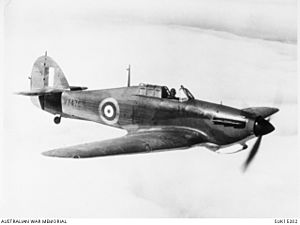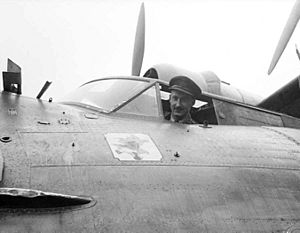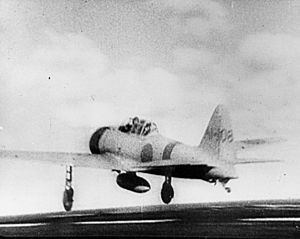Easter Sunday Raid facts for kids
Quick facts for kids Easter Sunday Raid on Ceylon |
|||||||
|---|---|---|---|---|---|---|---|
| Part of the Pacific Theatre of World War II | |||||||
|
|||||||
| Belligerents | |||||||
| Casualties and losses | |||||||
| 7 aircraft |
26 aircraft |
||||||
The Easter Sunday Raid was a surprise air attack on Colombo, Ceylon (now Sri Lanka). It happened on 5 April 1942 during World War II. Japanese aircraft, launched from huge ships called aircraft carriers, carried out the attack.
The main goal for Japan was to destroy the British Eastern Fleet. This fleet was based in Ceylon's harbours. However, the British knew about the attack beforehand. They moved their ships out of the harbours before the raid began.
British planes from the Royal Air Force (RAF) and the Royal Navy's Fleet Air Arm fought back. Anti-aircraft guns also fired at the Japanese planes. Some port buildings were damaged, and a few ships were sunk or hit. But most of the British fleet escaped.
This raid showed that Ceylon was not safe from air attacks. After this, the British Eastern Fleet moved its main base to East Africa. From there, they could still send their ships into the Indian Ocean.
Contents
Why the Attack Happened
British Get Ready
When Japan joined World War II, Ceylon's air defenses were very weak. There were only a few old anti-aircraft guns. The RAF only had one squadron with outdated planes.
But after Singapore was lost in February 1942, Ceylon became super important. It was key for defending India and keeping supply routes open in the Indian Ocean. The British knew Japan might attack Ceylon from aircraft carriers. This had happened at Pearl Harbor and Darwin.
So, Ceylon's air defenses were quickly made stronger in early 1942. Many Hawker Hurricane fighter planes arrived. More anti-aircraft guns were also brought in.
The British also got Consolidated PBY Catalina flying boats. These planes could fly long distances. They were used to spot and follow the Japanese fleet during the raid.
Airbases near Colombo and Trincomalee were made bigger. A new airbase was even set up at the Colombo Racecourse. This helped reduce crowding at other bases. The Japanese did not know about these new bases.
Colombo and Trincomalee also got new radar stations. Radar helps detect planes from far away.
Japanese Get Ready
The Japanese Navy planned this attack, calling it "Operation C." They decided to leave their base on 26 March. The attack on Colombo was set for 5 April. These dates were followed exactly.
The main Japanese force was led by Admiral Chūichi Nagumo. It included five powerful aircraft carriers: Akagi, Shōkaku, Zuikaku, Sōryū, and Hiryū.
First Moves
Allied spies found out about the Japanese plans. The British thought the attack would be on 1 April. So, British forces in Ceylon went on high alert a few days too early.
The British Eastern Fleet, led by Vice Admiral Sir James Somerville, sailed out on 30 March. They waited about 100 miles south of Ceylon. British planes also searched the area. This was exactly where the Japanese would approach.
When no Japanese ships were seen, the British fleet went to Addu Atoll to refuel. This place was about 600 miles southwest of Ceylon. Some ships, like the cruisers Cornwall and Dorsetshire, were sent back to Colombo. The British air defenses relaxed, but long-range Catalina patrols continued.
The Attack on Colombo
Japanese Fleet Arrives
Early on 4 April, a Catalina plane, piloted by Squadron Leader Leonard Birchall, took off from Koggala. It was on a patrol flight. Later that day, Birchall's crew spotted the Japanese fleet far away to the south-east of Ceylon.
Japanese Mitsubishi A6M Zero fighters attacked the Catalina. The plane's radio was damaged while it was sending the message. So, the British knew a fleet was coming, but not how big it was. The Catalina was forced to land on the water and was sunk. Only six of the nine crew, including Birchall, survived and were captured.
Another Catalina plane then took over watching the Japanese fleet. It sent more reports until it was shot down.
Within an hour of Birchall's report, British commanders met. They prepared for a Japanese attack at dawn. Ships were told to leave the harbours in Colombo and Trincomalee. The cruisers Cornwall and Dorsetshire left Colombo late on 4 April.
British Warning System Fails
Just after 6:00 AM on 5 April, Japanese carriers launched 91 bombers and 36 fighters. They were heading for Colombo.
A British Catalina plane spotted four Japanese aircraft. But the pilot thought they were British planes and did not report them. The Japanese planes approached Colombo from the sea. This way, they avoided being seen by coast watchers or radar. The radar station also failed to detect the incoming attack.
British fighter pilots waited for an order to take off. But because there was no early warning, the order never came. They had to take off while under attack.
The Attack Begins

At 7:30 AM, nine Japanese Zero fighters flew over the Colombo Racecourse airbase. British Hurricanes from 258 Squadron quickly took off. The airbase itself was not attacked.
At 7:40 AM, Japanese bombers were seen near Ratmalana airbase. As Hurricanes from 30 Squadron were taking off, 14 bombers attacked the base. 21 Hurricanes managed to get into the air. Six Fulmar planes also took off. These British fighters fought hard to defend the airbase. They shot down five Japanese bombers and one Zero. Eight Hurricanes and three Fulmars were lost. The airbase was not badly damaged.
Other Japanese bombers attacked the harbour around 7:50 AM. They sank a ship called HMS Hector and damaged a submarine support ship. British fighters from 258 Squadron attacked these bombers. They shot down one bomber and damaged another. But they lost eight Hurricanes.
The remaining Japanese bombers attacked the harbour and port without much resistance. They damaged a British tanker and sank an old destroyer, HMS Tenedos. Other ships and port buildings were also hit.
The Japanese planes returned to their carriers between 9:45 AM and 10:30 AM.
Second Attack Cancelled
The Japanese had a reserve force ready for a second attack on Colombo. But this was cancelled. Japanese scout planes found the British cruisers Dorsetshire and Cornwall at 10:00 AM. The Japanese then focused on sinking these two ships instead.
What Happened Next
British Plane Losses
The British suffered significant losses. 30 Squadron RAF had only seven working planes left by nightfall. Eight Hurricanes were shot down, and five pilots were killed.
258 Squadron RAF lost eight Hurricanes, and five pilots died.
The Fleet Air Arm lost four Fulmar planes, and three pilots were killed.
Six Fairey Swordfish planes were also shot down. These planes were flying to Colombo during the attack and arrived right in the middle of it.
Radar Problems
The radar station at Colombo was working during the battle. But it did not detect the incoming Japanese planes. Later, experts said this was due to technical limits of the radar. Also, the operators might have been tired and made mistakes.
The radar was new, and operators might not have known how to tell real signals from false ones. The way the Japanese planes flew might have also helped them avoid detection.
Even if the radar had worked perfectly, there was very little time. It took five minutes for British planes to take off and another six minutes to climb high enough to fight. This left only six minutes for the radar to report, and for orders to be given to the pilots.
Awards
Leonard Birchall was given an award called the Distinguished Flying Cross. This was for spotting the Japanese fleet on 4 April. Canadian news called him the "Saviour of Ceylon." He was a prisoner of war for the rest of the war.
See also
- Ceylon in World War II



